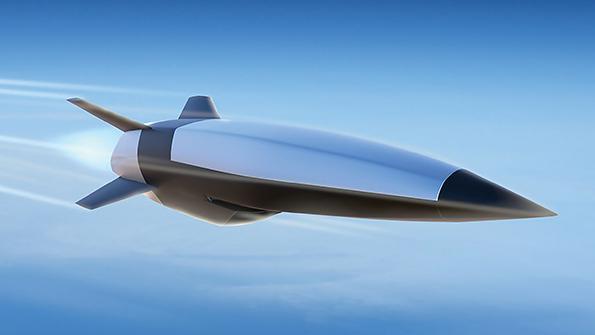The Air Force expects to fly 13 tests of the Hypersonic Attack Cruise Missile between October 2024 and March 2027, with a production decision to follow if the project is successful, the Government Accountability Office revealed in a new report.
GAO’s annual Weapon System Assessment report, released in mid-June, says the air-breathing hypersonic missile program is slated to undergo a critical design review in 2025 and transition from a rapid prototyping/mid-tier acquisition to a major defense program in 2027. However, the CDR will reflect an initial version of the missile, which will be refined as the test program progresses, and there will in effect be a “rolling” CDR. Production could begin as early as 2027.
Raytheon is the prime contractor for HACM, and Northrop Grumman is developing its scramjet engine.
Development of HACM will cost $1.9 billion, which will cover the 13 test missiles, associated engineering and materials, and an undisclosed number of additional all-up missiles when testing has concluded, providing a “residual operational capability.”
The arrangement is similar to that for the AGM-131 Air-launched Rapid Response Weapon, made by Lockheed Martin Missile and Fire Control, which has largely concluded testing. However, the Air Force has been deliberately ambiguous about whether it has plans for further testing or production of ARRW.
Unlike ARRW, which is a boost-glide hypersonic weapon, HACM is a rocket-boosted, air-breathing system with longer range that can change course en route to target and therefore complicate defenses against it. The Air Force has long shown a preference for HACM because it’s smaller than ARRW, has a longer range, and can be carried on fighter-seized aircraft. The ARRW is limited to a large platform like the B-52 bomber, from which all its test fights were made.
Air Force budget documents for fiscal 2025 describes the two missiles as “complementary.”
HACM got its start in fiscal 2022 in a joint Air Force/Defense Advanced Research Projects Agency effort called the Hypersonic Air-breathing Weapon Concept, or HAWC, which served as a prototype for HACM. Raytheon was chosen to develop the weapon over competitors Boeing and Lockheed in 2022.
“According to officials, the launch aircraft, booster, payload, and guidance system, along with an interstage that connects the cruiser and booster, are new to HACM and make it operationally capable,” the GAO report disclosed.
The 2027 production date depends on “what capabilities the Air Force is willing to accept and whether production facilities are ready,” the GAO report added.
The program got underway without a formal schedule risk assessment, but one was approved in June 2023, the report said. “Our prior work has shown that this type of information is important to help decision-makers make well-informed decisions about [mid-tier acquisition] program initiation. This includes whether the program is likely to meet the statute-based objective of fielding a prototype that can be demonstrated in an operational environment and provide for a residual operational capability within 5 years of program start.”
The HACM has direction from Air Force leadership “to move as quickly as possible, and schedule risk assessments would likely note that higher level of risk,” the watchdog agency noted.
Requirements, an acquisition strategy, a formal technology risk assessment, and an independent cost estimate were all completed before the program was officially launched. The Air Force approved HACM requirements in November 2021, but the Joint Requirements Oversight Council has not yet “validated” those requirements, the GAO reported. However, this is expected to happen before HACM transitions to a major defense program.
The agency said the Air Force believes the “critical technologies underpinning HACM design were either immature or nearing maturity” at the program go-ahead, but “the program expects them to be fully mature by the end of the rapid prototyping effort.”
In addition to an iterative design approach, the HACM program is using digital design tools and “fully digital design reviews,” the GAO report states. However, the program is not creating a digital twin of the missile at this stage, although there may be one in the future.
The program office told GAO officials that digital reviews are challenging because of “the sheer number of tools, licensing restrictions, limited computing power, and the logistics of doing so in a way that is accessible to the large number of program stakeholders.”
GAO officials suggested “incorporating continuous user feedback” through the design cycles, something the program apparently isn’t planning to do.
“Program officials did state that users could provide some feedback during operational testing, but this would primarily serve to facilitate users learning the system, rather than informing the design,” the GAO report noted
Because all of the Pentagon’s hypersonic projects are vying for access to a limited number of facilities and test ranges, HACM is being integrated with the Southern Cross Integrated Flight Research Experiment, a joint U.S.-Australian effort. The GAO report said “several” HACM tests will take place in Australia, launched off Royal Australian Air Force F/A-18s. Air Force budget documents refer to SCIFIRE as a “prelude” to HACM.
The Air Force budget said fiscal 2025 activities on HACM will include continuing design and integration on the F-15E and F/A-18E/F aircraft, and “free flight testing of HACM prototypes.”
The research and development budget for HACM calls for $516.9 million in 2025; $448.6 million in 2026, $274.1 million in 2027, $200.8 million in 2028, and $202.6 million in 2029, at which point development is set to conclude.


